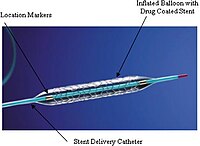
Longitudinal Hemodynamics of Transcatheter and Surgical Aortic Valves in the PARTNER Trial
Sign Up to like & getrecommendations! Published in 2017 at "JAMA Cardiology"
DOI: 10.1001/jamacardio.2017.3306
Abstract: Importance Use of transcatheter aortic valve replacement (TAVR) for severe aortic stenosis is growing rapidly. However, to our knowledge, the durability of these prostheses is incompletely defined. Objective To determine the midterm hemodynamic performance of… read more here.
Keywords: trial; partner; transcatheter heart; aortic valve ... See more keywords

Enteral Stents for Malignant Gastric Outlet Obstruction: Low Reintervention Rates for Obstruction due to Pancreatic Adenocarcinoma Versus Other Etiologies
Sign Up to like & getrecommendations! Published in 2020 at "Journal of Gastrointestinal Surgery"
DOI: 10.1007/s11605-019-04512-6
Abstract: Background and Aim Enteral stents (ES) have emerged as first-line therapy for the treatment of malignant gastric outlet obstruction (GOO). Stent occlusion arising from tissue ingrowth may require endoscopic or surgical reintervention. The objective of… read more here.
Keywords: enteral stents; malignant gastric; reintervention; gastric outlet ... See more keywords

Reinterventions after Endovascular Revascularization in Elderly Patients with Critical Limb Ischemia: An Observational Study.
Sign Up to like & getrecommendations! Published in 2018 at "Annals of vascular surgery"
DOI: 10.1016/j.avsg.2018.04.021
Abstract: BACKGROUND Endovascular-first strategy for critical limb ischemia is widely accepted, especially in elderly patients, because of the increasing patency rates and minimally invasive character. Nonetheless, the impact of reinterventions because of endovascular treatment failure in… read more here.
Keywords: reintervention; limb ischemia; endovascular revascularization; critical limb ... See more keywords

Survival and Reintervention Risk by Patient Age and Preoperative Abdominal Aortic Aneurysm Diameter after Endovascular Aneurysm Repair.
Sign Up to like & getrecommendations! Published in 2019 at "Annals of vascular surgery"
DOI: 10.1016/j.avsg.2018.05.053
Abstract: BACKGROUND Endovascular aneurysm repair (EVAR) has become the standard of care for abdominal aortic aneurysm (AAA), but questions remain regarding the benefit in high-risk and elderly patients. The purpose of this study was to examine… read more here.
Keywords: risk; aneurysm; age; patient age ... See more keywords

Limb occlusion rate after EVAR with individualized graft limb selection and a liberal protocol of primary relining.
Sign Up to like & getrecommendations! Published in 2021 at "Annals of vascular surgery"
DOI: 10.1016/j.avsg.2021.02.046
Abstract: PURPOSE This study analyses limb occlusion rates after endovascular aneurysm repair (EVAR) with a strategy including stent-graft limb selection and liberal primary stenting (relining) in anatomies at higher risk for occlusion with uncovered self-expandable or… read more here.
Keywords: patency; limb; graft; reintervention ... See more keywords

Long-Term Outcomes of Patients Undergoing the Ross Procedure.
Sign Up to like & getrecommendations! Published in 2021 at "Journal of the American College of Cardiology"
DOI: 10.1016/j.jacc.2021.01.034
Abstract: BACKGROUND Treatment of aortic-valve disease in young patients still poses challenges. The Ross procedure offers several potential advantages that may translate to improved long-term outcomes. OBJECTIVES This study reports long-term outcomes after the Ross procedure.… read more here.
Keywords: long term; year; procedure; reintervention ... See more keywords

Early reintervention after open and endovascular abdominal aortic aneurysm repair is associated with high mortality.
Sign Up to like & getrecommendations! Published in 2018 at "Journal of vascular surgery"
DOI: 10.1016/j.jvs.2017.06.104
Abstract: OBJECTIVE Although reinterventions are generally considered more common after endovascular aneurysm repair (EVAR) than after open surgical repair (OSR), less is known about reintervention in the early postoperative period. Furthermore, there are few data regarding… read more here.
Keywords: mortality; reintervention; aneurysm repair; day ... See more keywords

Increasing the Supply of Vascular Surgeons to Meet the Rising Demand for Vascular Service: Are We Doing Enough?: SS17.
Sign Up to like & getrecommendations! Published in 2018 at "Journal of Vascular Surgery"
DOI: 10.1016/j.jvs.2018.03.232
Abstract: models with log-rank tests to determine survival in Kaplan-Meier curves. P < .05 was the threshold for significance. Results: There were 342 infrapopliteal interventions performed on 290 patients at a mean age of 67.36 12.6… read more here.
Keywords: atherectomy group; patency rates; increasing supply; reintervention ... See more keywords

Outcomes of endovascular treatments for in‐stent restenosis in patients with mesenteric atherosclerotic disease
Sign Up to like & getrecommendations! Published in 2019 at "Journal of Vascular Surgery"
DOI: 10.1016/j.jvs.2018.08.166
Abstract: Objective Mesenteric angioplasty and stenting (MAS) has surpassed open revascularization as the treatment of choice for mesenteric ischemia. Despite the lower perioperative mortality associated with MAS, the need for reintervention is not infrequent. The purpose… read more here.
Keywords: patency; stent restenosis; mortality; reintervention ... See more keywords

Laparotomy- and groin-associated complications are common after aortofemoral bypass and contribute to reintervention.
Sign Up to like & getrecommendations! Published in 2020 at "Journal of vascular surgery"
DOI: 10.1016/j.jvs.2019.09.067
Abstract: BACKGROUND Despite endovascular advancements, aortofemoral bypass (AFB; aortounifemoral and aortobifemoral bypass) remains the most durable option for aortoiliac occlusive disease. Whereas AFB reduces vascular aortoiliac reintervention, the impact of laparotomy-associated and groin wound complications on… read more here.
Keywords: bypass; wound complications; reintervention; groin ... See more keywords

Patients with Failed Femoropopliteal Covered Stents are More Likely to Present with Acute Limb Ischemia than Those with Failed Femoropopliteal Bare-Metal Stents.
Sign Up to like & getrecommendations! Published in 2021 at "Journal of vascular surgery"
DOI: 10.1016/j.jvs.2021.01.029
Abstract: OBJECTIVES Covered stents (CS) to treat superficial femoral artery (SFA) occlusive disease have become more common. However, concerns about patients presenting with acute limb ischemia (ALI) after failure due to coverage of important collaterals have… read more here.
Keywords: index; index procedure; failed femoropopliteal; reintervention ... See more keywords